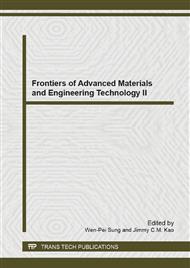[1]
T. S. Ke: Foundation of Internal Friction Theory in Solids (Grain-boundary Relaxation and Grain-boundary Structure), Academic Press, Beijing (2000).
Google Scholar
[2]
E. D. Brandner, B. S. Shivaram, A. Munier: Meas. Sci. Technol., Vol. 6 (1995), 310-313.
Google Scholar
[3]
A. S. Nowick and B. S. Berry: Anelastic Relaxation in Crystalline Solids, Academic Press, Now York and London (1972).
Google Scholar
[4]
D. Feng, et al: in: Metal Physics, Vol. 3 (Mechanical properties of Metals), Academic Press, Beijing (2000).
Google Scholar
[5]
T. S. Ke: Advances in Mechanics, Vol. 24 (1994), 336-350.
Google Scholar
[6]
Z. G. Zhu, C. H. Gu, F. K. Xie, et al: Physics, Vol. 14 (1985), 489-490.
Google Scholar
[7]
Y. D. Wen, L. T. Wang, J. J. Du: Physics, Vol. 15 (1986), 109-110.
Google Scholar
[8]
Z. G. Zhu, X. Zhou, G. T. Fei: Chinese Journal of Scientific Instrument, Vol. 9 (1988), 396-401.
Google Scholar
[9]
J. Wang, Z. G. Zhu, G. T. Fei: Analysis and Testing Technology and Instruments, Vol. 2 (1996), 42-44.
Google Scholar
[10]
H. Zhou, Q. P. Kong: Physical Testing and Chemical Analysis Part A: Physical Testing, Vol. 3 (1997), 29-30.
Google Scholar
[11]
Y. Dai, Q. P. Kong, Q. H. Ni, Z. X. Zhou: Physics, Vol. 16 (1987), 293-294.
Google Scholar
[12]
X. D. Ding, K. Gong, et al: Journal of Sun Yat-sen University, Vol. 39 (2000), 30-34.
Google Scholar
[13]
Q. F. Fang, X. P. Wang, X. B. Wu, et al: Physics, Vol. 40 (2011), 785-793.
Google Scholar
[14]
Z. G. Zhu, X. B. Wu, et al: Journal of Shanghai Jiaotong University, Vol. 44 (2010), 669-673.
Google Scholar
[15]
J. C. Swartz: Rev. Sci. Instrum, Vol. 32 (1961), 335-338.
Google Scholar
[16]
J. E. Harbottle: Journal of Physics E: Scientific Instruments, Vol. 3 (1970), 49-54.
Google Scholar
[17]
D. E. Barrow, Z. C. Szkopiak: Journal of physics E: Scientific Instruments, Vol. 5 (1972), 915-919.
Google Scholar
[18]
J. Woirgard , Y. Sarrazin, H. Chaumet: Rev. Sci. Instrum., Vol. 48 (1977), 1322-1325.
Google Scholar
[19]
E. D. Brandner, B. S. Shivaram, A. Munier: Meas. Sci. Technol., Vol. 6 (1995), 310-313.
Google Scholar
[20]
T. T. Gribb, R. F. Cooper: Review of Scientific Instrument, Vol. 69 (1998), 559-564.
Google Scholar
[21]
J. M. San Juan, I. Gallegoy, M. L. Nó: Rev. Metal. Madrid, Vol. 37 (2001), 209-214.
Google Scholar
[22]
T. Tondellier, J. Woirgard, J. L. Demenet: Defects and Diffusion in Ceramics, Vol. 206-207 (2002), 175-178.
DOI: 10.4028/www.scientific.net/ddf.206-207.175
Google Scholar
[23]
I. Gutiérrez-urrutia, M. L. Nó: Mater. Sci. Eng. A, Vol. 37 (2004), 435-439.
Google Scholar


